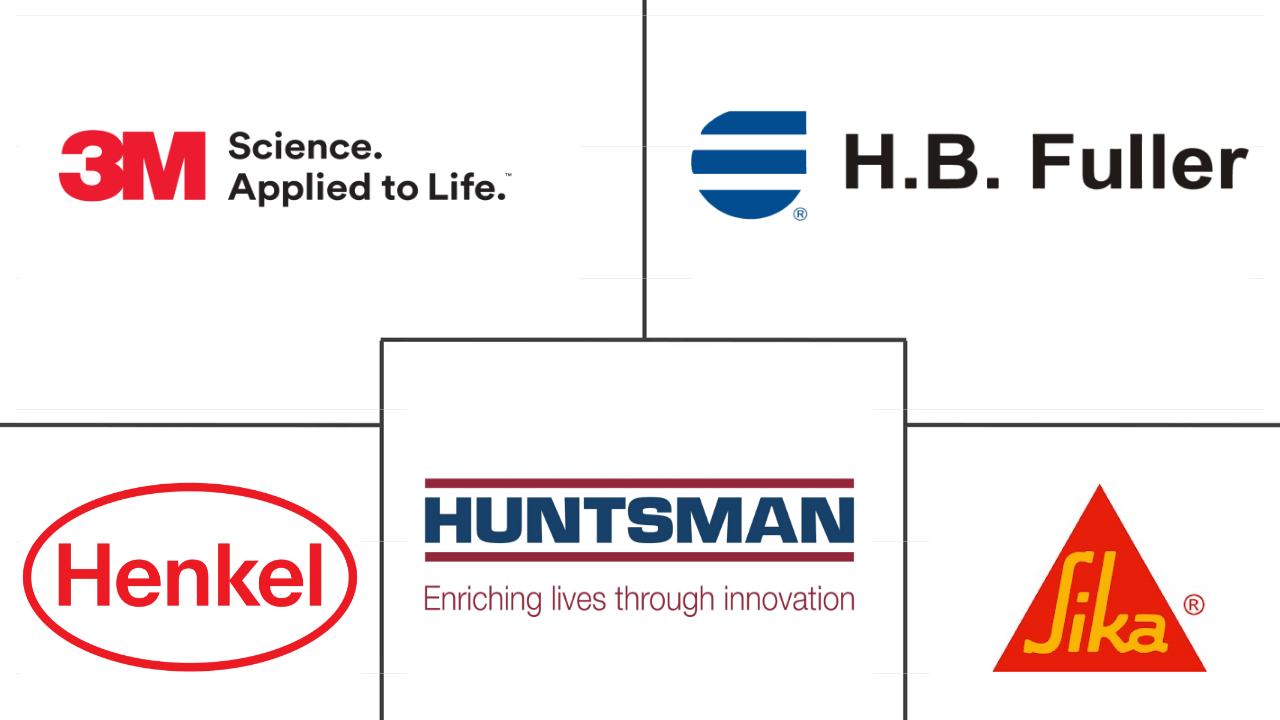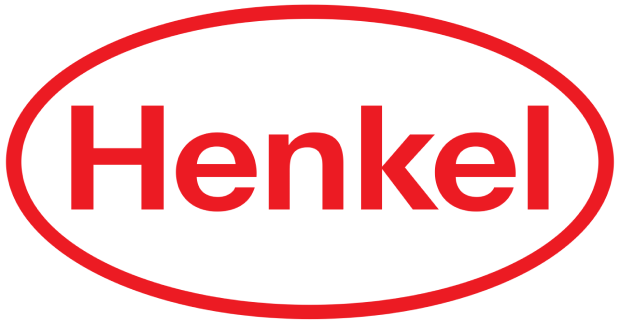Market Size of europe automotive adhesives & sealants Industry
| Icons | Lable | Value |
|---|---|---|
|
|
Study Period | 2017 - 2028 |
|
|
Market Size (2024) | USD 1.51 Billion |
|
|
Market Size (2028) | USD 1.82 Billion |
|
|
Largest Share by Resin | Polyurethane |
|
|
CAGR (2024 - 2028) | 4.73 % |
|
|
Largest Share by Country | Germany |
|
|
Market Concentration | High |
Major Players |
||

|
||
|
*Disclaimer: Major Players sorted in no particular order |
Europe Automotive Adhesives & Sealants Market Analysis
The Europe Automotive Adhesives & Sealants Market size is estimated at 1.51 billion USD in 2024, and is expected to reach 1.82 billion USD by 2028, growing at a CAGR of 4.73% during the forecast period (2024-2028).
1.51 Billion
Market Size in 2024 (USD)
1.82 Billion
Market Size in 2028 (USD)
0.22 %
CAGR (2017-2023)
4.73 %
CAGR (2024-2028)
Largest Market by Technology
38.71 %
value share, Reactive, 2023
In Europe, reactive technology accounts for the highest market share due to its wide-ranging applications in the automotive industry for assembling, repairing, and thread-locking, among others.
Largest Market by Resin
26.48 %
value share, Polyurethane, 2023
Polyurethane resins hold the largest market share owing to their wide-ranging applications in the automotive industry, specifically for exterior applications.
Largest Market by Country
18.65 %
value share, Germany, 2023
With the presence of a huge number of automotive manufacturers and their manufacturing operations, Germany holds the largest market share in Europe.
Fastest Growing Market by Country
5.95 %
Projected CAGR, United Kingdom, 2024-2028
Due to the rising concern toward carbon emission norms and rapidly growing demand for electric vehicles, France is projected to be the fastest-growing country over the forecast period.
Leading Market Player
43.75 %
market share, Henkel AG & Co. KGaA, 2021

Henkel is the leading automotive adhesives and sealants producer in the region, delivering high-performance solutions to meet the changing demand from the automotive industry.
Increasing shift toward vehicle electrification by automobile players to propel market growth
- Polyurethane, epoxy, and acrylic resins account for a large share of the European automotive adhesives and sealants market. The share of polyurethane resins is higher as they are most commonly used in the automotive industry to manufacture high-resilience foam seating, rigid foam insulation panels, B-pillars, headliners, suspension insulators, bumpers and other interior parts of light commercial vehicles, cars, and electric vehicles.
- In Europe, the usage of epoxy resins is increasing in countries like Germany, Russia, Poland, France, the United Kingdom, Belgium, and Italy. The use of lightweight resins in automotive vehicle parts increased along with automotive vehicle production capacities in these countries. In 2021, the production of light commercial vehicles increased to 2.1 million units, an increase of 1% over 2020. Thus, the usage of acrylic, silicone, and other resin-based adhesives and sealants increased in the region.
- The stringent emission norms implemented by governments in the region and the shift toward vehicle electrification by players are expected to boost the growth of the European automotive adhesives market over the forecast period. The market is expected to witness significant growth owing to the benefits offered by automotive adhesives over traditional metal welding. Automotive adhesives also reduce the noise, harshness, and vibration of the vehicle and provide comfortable driving. Hence, owing to such factors, the market is estimated to register a CAGR of 4.57% during the forecast period (2022-028).
Government legislations to reduce Co2 emissions to boost electric vehicle manufacturing in turn boosting market demand
- Europe's automotive adhesives and sealants demand declined slightly in 2018 and 2019 due to changes in global vehicle standards and demand falls in western Europe and international trade conflicts. In 2020, Europe's automotive adhesives and sealants demand decreased by 20% as vehicle production fell from 21.56 million units in 2019 to 16.9 million units in 2020 due to operational and supply chain restrictions caused by the COVID-19 pandemic.
- Germany has the largest share of the demand for automotive adhesives and sealants among European countries due to its large manufacturing capacity, which is supported by the integrated value chain and R&D infrastructure of the country. In 2021, Germany manufactured 3.3 million units which constitute up to 20% of the total vehicles manufactured in Europe.
- Polyurethane and epoxy-based adhesives and sealants are most commonly used in the region because they can be used as structural adhesives to enhance the load-bearing capacity of the vehicle. They also offer heat and chemical resistance along with electric insulation, which makes them ideal for PCB (Printed Circuit Board) applications. In 2021, 85 million kilograms of polyurethane-based products were consumed, and by 2028 this is expected to reach 105.6 million kilograms with a CAGR of 3.16%.
- As part of the European commission's climate goals to reduce greenhouse house emissions by at least 55% by 2030. The legislation 'Fit for 55' sets targets to reduce CO2 emissions from cars by 55% and vans by 50% by 2030. This regulation has boosted the demand for electric vehicles, which in turn is expected to boost the demand for PU, acrylic, and silicone-based products in the forecast period, as they can also be used in automotive electronics.
Europe Automotive Adhesives & Sealants Industry Segmentation Europe Automotive Adhesives & Sealants Industry Segmentation
Acrylic, Cyanoacrylate, Epoxy, Polyurethane, Silicone, VAE/EVA are covered as segments by Resin. Hot Melt, Reactive, Sealants, Solvent-borne, UV Cured Adhesives, Water-borne are covered as segments by Technology. France, Germany, Italy, Russia, Spain, United Kingdom are covered as segments by Country.
- Polyurethane, epoxy, and acrylic resins account for a large share of the European automotive adhesives and sealants market. The share of polyurethane resins is higher as they are most commonly used in the automotive industry to manufacture high-resilience foam seating, rigid foam insulation panels, B-pillars, headliners, suspension insulators, bumpers and other interior parts of light commercial vehicles, cars, and electric vehicles.
- In Europe, the usage of epoxy resins is increasing in countries like Germany, Russia, Poland, France, the United Kingdom, Belgium, and Italy. The use of lightweight resins in automotive vehicle parts increased along with automotive vehicle production capacities in these countries. In 2021, the production of light commercial vehicles increased to 2.1 million units, an increase of 1% over 2020. Thus, the usage of acrylic, silicone, and other resin-based adhesives and sealants increased in the region.
- The stringent emission norms implemented by governments in the region and the shift toward vehicle electrification by players are expected to boost the growth of the European automotive adhesives market over the forecast period. The market is expected to witness significant growth owing to the benefits offered by automotive adhesives over traditional metal welding. Automotive adhesives also reduce the noise, harshness, and vibration of the vehicle and provide comfortable driving. Hence, owing to such factors, the market is estimated to register a CAGR of 4.57% during the forecast period (2022-028).
| Resin | |
| Acrylic | |
| Cyanoacrylate | |
| Epoxy | |
| Polyurethane | |
| Silicone | |
| VAE/EVA | |
| Other Resins |
| Technology | |
| Hot Melt | |
| Reactive | |
| Sealants | |
| Solvent-borne | |
| UV Cured Adhesives | |
| Water-borne |
| Country | |
| France | |
| Germany | |
| Italy | |
| Russia | |
| Spain | |
| United Kingdom | |
| Rest of Europe |
Europe Automotive Adhesives & Sealants Market Size Summary
The European automotive adhesives and sealants market is poised for steady growth, driven by the increasing demand for lightweight and high-performance materials in vehicle manufacturing. Polyurethane, epoxy, and acrylic resins dominate the market due to their extensive applications in producing components such as seating, insulation panels, and interior parts for various vehicle types, including electric vehicles. The shift towards vehicle electrification and stringent emission regulations are further propelling the adoption of these materials, as they offer advantages over traditional metal welding, such as reduced noise and improved driving comfort. Despite past challenges like the COVID-19 pandemic and geopolitical tensions affecting vehicle production, the market is expected to recover and expand, supported by investments in electric vehicle production across Europe.
Germany leads the demand for automotive adhesives and sealants in Europe, bolstered by its robust manufacturing capabilities and research infrastructure. The market is fairly consolidated, with major players like 3M, H.B. Fuller Company, Henkel AG & Co. KGaA, Huntsman International LLC, and Sika AG holding significant shares. Recent strategic partnerships and product launches, such as ITW Performance Polymers' distribution agreement in Poland and the introduction of new adhesives, highlight ongoing innovation and collaboration in the sector. As Europe continues to focus on reducing greenhouse gas emissions and enhancing vehicle efficiency, the demand for polyurethane, acrylic, and silicone-based products is expected to rise, aligning with the region's climate goals and automotive industry trends.
Europe Automotive Adhesives & Sealants Market Size - Table of Contents
-
1. MARKET SEGMENTATION (includes market size in Value in USD and Volume, Forecasts up to 2028 and analysis of growth prospects)
-
1.1 Resin
-
1.1.1 Acrylic
-
1.1.2 Cyanoacrylate
-
1.1.3 Epoxy
-
1.1.4 Polyurethane
-
1.1.5 Silicone
-
1.1.6 VAE/EVA
-
1.1.7 Other Resins
-
-
1.2 Technology
-
1.2.1 Hot Melt
-
1.2.2 Reactive
-
1.2.3 Sealants
-
1.2.4 Solvent-borne
-
1.2.5 UV Cured Adhesives
-
1.2.6 Water-borne
-
-
1.3 Country
-
1.3.1 France
-
1.3.2 Germany
-
1.3.3 Italy
-
1.3.4 Russia
-
1.3.5 Spain
-
1.3.6 United Kingdom
-
1.3.7 Rest of Europe
-
-
Europe Automotive Adhesives & Sealants Market Size FAQs
How big is the Europe Automotive Adhesives & Sealants Market?
The Europe Automotive Adhesives & Sealants Market size is expected to reach USD 1.51 billion in 2024 and grow at a CAGR of 4.73% to reach USD 1.82 billion by 2028.
What is the current Europe Automotive Adhesives & Sealants Market size?
In 2024, the Europe Automotive Adhesives & Sealants Market size is expected to reach USD 1.51 billion.

